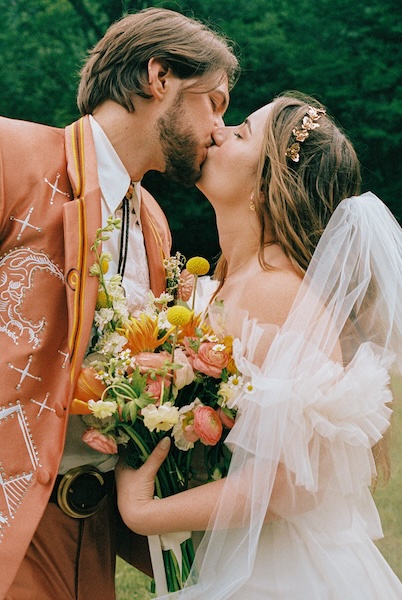Black (and White) is Back
April 10, 2013
When Blair deLaubenfels, co-founder of wedding blog, Junebug Weddings, was vetting photographers for the website’s annual list of “World’s Best Wedding Photographers” last year, she noticed that many of the applicants were submitting black-and-white images.
“The photographs were a little bit softer, and had a more timeless feel,” she says. “We also noticed that many photographers were returning to medium- and large-format film, and wet-plate collodion finishing, which was very exciting.”
DeLaubenfels first started compiling the “best of” photographers’ list in 2008, and it became so popular that in 2012, Junebug received over 7,000 applicants from 39 countries for the competition. “Because we see so many photographs, we get a sense of how trends are changing around the world,” she explains. “We realized that it’s the photographers themselves who are setting the trends—the market then follows.”
DeLaubenfels says one of the reasons she has noticed that photographers are increasingly experimenting with more technically difficult—and less traditional—processes associated with monochrome imagery is that wedding photography, once looked down upon by the fine arts community, is progressively being considered a respectable art form. “Wedding photographers are up-leveling their work,” she says. “They’re looking for new ways to express themselves, and their output is increasingly phenomenal.”
Of the many applicants she has seen, deLaubenfels notes that three have been producing particularly strong work: Jean-Pierre Uys, Richard Israel and Neale James. Each comes from very different regions—Uys is based in South Africa, Israel in North Carolina and James in the United Kingdom—and do not necessarily produce visually-comparable images. What binds them together, aside from a predilection for black- and-white photography, is that their extraordinary talent grants them some autonomy within the industry. Rather than being merely hired hands, they consider themselves to be artists. “Clients don’t tell me what to do,” explains Uys. “They respect me on an artistic level, and let me do what I want.”
Uys stumbled into photography through filmmaking, which he studied in college. “My mother gave me a camera as a gift when I was 21,” he says. “I didn’t really want to become a photographer—in South Africa, the profession was associated with the sort of guy who wore a flannel shirt and came to take your school portrait.”
His perception changed when he met a wedding photographer from overseas. “He dressed cool, and had a cool car,” Uys says, laughing. “He was making pretty good money—he inspired me.” After assisting on a few weddings, Uys realized he could take even better images than his mentor. “The pursuit of perfecting the craft was really enjoyable,” he says. “That’s how I knew I’d be good at it.”
Inspired by iconic photographers such as Henri Cartier-Bresson and George Brassaï, Uys began mixing black-and-white images in with his color photography during weddings. “It seemed natural—you have black suits with white wedding dresses,” he says. “It made for the perfect contrast.”
Although his monochrome images received many compliments, Uys was most drawn to the way they made him feel while he was shooting. Unlike many other photographers, who shoot in color and then convert their images to gray scale in Photoshop, Uys frequently snaps in RAW black and white. “It puts me in a certain mood,” he says. “I feel so good in the moment.”
Uys very rarely shoots using film—he says the quality of processing labs in South Africa has declined so much that it’s not worth his while—but he finds a connection to his origins in the darkroom during his printing process. “I print on Hahnemühle paper from Germany, which has been produced since the 16th century,” he says. “The combination of the black-and-white imagery on the high- quality paper makes the photographs appear more old-fashioned.” Blown up, the images are grainier—details emerge on the paper that are lost in pixels on the computer screen. The final product makes Uys feel deeply satisfied.
Ultimately, says Uys, black and white makes you look beyond the image, and allows you to focus on the moment that was captured. Neale James, who approaches his craft as a documentarian, agrees wholeheartedly. “Black and white gives you that emotional connect that’s missing in color,” he says. “Someone once told me that if you show the picture in color, you look at the clothes—if you display in black and white, you look at the soul.”
James began his career as a broadcaster for BBC radio. Frequently, on assignment, he met with photographers who introduced him to still photography. “They taught me how to cut my teeth in the dark room,” he says.
In 2005, he was dragged “kicking and screaming” to shoot the wedding of a friend. “It was only because he made me feel so guilty for saying no,” he explains. Like many of his contemporaries, James believed at the time that wedding photography was a lesser endeavor than other types of image-making. Today, he shoots up to 80 weddings a year. “Most people don’t know how to describe me, so they say I’m prolific,” he says, laughing.
When he first started, James was interested in war photography by photojournalists such as Robert Capa and Don McCullin. After shooting a few weddings, he realized that humanity is present at celebrations just as it is in conflict zones. Although he still shoots portraits in color with his digital camera, what really appeals to his clients are the candids he takes with black-and-white film. “They aren’t wedding shots—they are legacy photographs,” he says. “They are relevant as time capsules.”
What’s most striking about James’ photographs is their incredible intimacy. His camera captures everything from the static electricity that exists in the second before lips meet for a kiss, to the history of a life written in lines on an old woman’s face as she gazes at her granddaughter in a wedding dress. “I use a 24mm lens so I can get up really close,” he says. “If you use a zoom lens, you’re always slightly detached from the moment.”
Unlike many of his contemporaries, James develops his black-and-white photographs in his own darkroom. “I love drawing out the darkness,” he says. “I want people to see tears spilling from watery eyes.”
Although most of his clients come to him already fans of his work, he has to convince some that black-and-white photography is valuable in a world saturated with color. In his waiting room, he keeps a book of photographs by the legendary printer Robin Bell. “I leave people for a second with that while I go make coffee,” he says. “It’s the perfect way to start a sales pitch—after they see the images, I don’t need to do any convincing.”
Much in the same way as Uys and Neale, Richard Israel never imagined he would become a wedding photographer. He began his career as a hair stylist for Vidal Sassoon in London, where he worked for 18 years. He only began taking photographs in the early 1980s because he wanted to immortalize his hair creations. “I got totally hooked,” he says. So he quit his day job, and did the “starving artist” thing for a while in Milan.
Before long, he became a highly sought-after fashion and beauty photographer. “I was doing quite a bit of fashion stories for wedding magazines, and from that work, getting a lot of requests to shoot weddings,” he says. Like many other photographers, he at first thought that it was demeaning to even be asked. “Quite frankly, I was very insulted at the time,” he says.
In the 1990s, wedding photographers were taking mainly stock imagery, which Israel described as “Martha Stewart stuff.” Still, he took a few jobs. “The wedding photography thing took on a life of its own,” he says. Today, he makes the majority of his income from shooting ceremonies.
Israel speaks with a heavy British accent; given his origins in the London fashion world, it seems strange that he would have ended up in Charlotte, North Carolina, where he now lives. “I met an American beauty on location who became my wife,” he says. Today, most of his clients are based in the Southeast of the United States, in locations such as Nashville, Atlanta and Charleston. Many of them are artists and musicians who appreciate his approach to the medium, which is heavily informed by historic photography.
At first glance, Israel’s images appear to be vintage prints from an earlier era. “I use a lot of old equipment,” he says. “I’ll shoot with a lens from the 1930s on a camera from the 1940s. The combo gives my work an authentic look.”
Although he still uses digital cameras, about 60 percent of his wedding photography—and 100 percent of the portraits he takes—are done with film. “I have become somewhat of an evangelist for a return to the medium,” he says of the resulting black-and-white shots, which he says gives his clients a “warm fuzzy feeling.”
Although he’d like to process his own film, he doesn’t have access to a darkroom. Still, even through the filter of Photoshop, his images retain an unmistakable scratchy trace from the celluloid, giving them a special something that appeals to his creative clients. “They notice the difference,” he says. “I am obsessed with what I do.”
One gets a sense, talking to Israel and his contemporaries, that the embrace of black-and-white photography is not necessarily about satisfying a client’s demands, rather, it is about elevating wedding photography into something more than just a service craft. “The trouble with wedding photography is the prefix ‘wedding,’ ” says James. “It has a real stigma in the photography industry. But there are some absolutely superb wedding photographers who deserve to be seen in a wider context.” When asked if he ever considered exhibiting his work in a gallery, he hesitated. “I don’t know if people would come see it,” he says.
He might be right for now; but if his work continues heading in the direction it’s going, he won’t be right forever.




